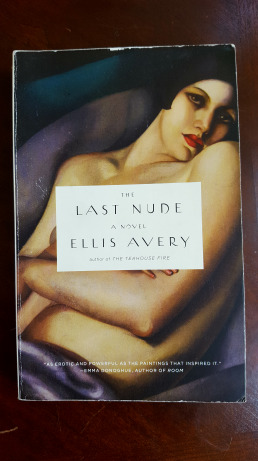I’m starting with this novel because it’s one of my favorites. Set in Paris in the late 1920s, the story is an imagined an affair between painter Tamara de Lempicka – a real historical figure, if you haven’t heard of her – and Rafaela, the unknown subject of a few of her paintings. The story of the affair is told from Rafaela’s point of view, with a smaller second section narrated by Tamara which covers her later years.
 The cover image is one of Tamara de Lempicka’s ‘Rafaela’ paintings.
The cover image is one of Tamara de Lempicka’s ‘Rafaela’ paintings.
It’s at times a gritty book, as it portrays not just the glittery side of the Jazz Age, but also the seedier parts of being a young woman alone in Paris in the 1920s with no money and no connections. The plot explores not just the deep desire between two women in different economic circumstances, but also larger themes about what it meant to survive as a woman at that time.
There are some twisty moments in Rafael’s narrative, so if you don’t know much about de Lempicka’s personal history, you may consider not looking too deeply into her before reading the novel. But even if you do know how her life progressed, it’s an excellent ride through a turbulent love affair between two women trying to find their way in the world.
Why you should read it:
- The unabashed lesbian love affair. There’s no moralizing, nor does anyone have any major identity crises. Sometimes it’s nice to read a tale of two women desiring each other without reservation or hesitation.
- There’s also no moralizing over the things that economically disadvantaged young women did to survive – it’s presented simply as their experiences, without any sense of judgment toward the women. (Toward society, maybe. But not the specific women.)
- Much like The Great Gatsby, it doesn’t romanticize the glittery lives of the wealthy – it shows both the seductive and the corrupt elements (and sometimes, they’re the same thing.)
- There are interesting twists, some based in historical fact, some that the author took license with, all of which completely work and kept me reading.
- For anyone interested in the Jazz Age, this book does a decent job of bringing Paris in the 1920s alive. The setting is not as present as it is in The Great Gatsby, but you definitely get a strong sense of the environment.
- For anyone interested in world politics, there are moments in the narrative where politics impact the characters and the decisions they make.
Reading tips for writers:
- Pay attention to how Avery presents young women in difficult situations without taking a moralistic tone, or going out of her way to justify what the girls do.
- The sex scenes are pretty successful – they’re not overdone, they move the reader along in the story, and I didn’t personally notice anything that pulled me out of the story.
- The Rafaela character is young when the main action takes place, but she’s narrating it from the future. I’m working on a story that does this, so it was interesting to me to see how an adult narrator remembers things that happened to her nearly two decades earlier. It definitely doesn’t feel like a teenager talking, but an older person remembering what it was like to be a teenager. This is an interesting narrative decision, and I’ve thought a lot about why the author chose a restrospective POV rather than simply writing Rafaela’s story from the POV of the seventeen year old.
- The narrative is split in two, but it’s not an even split, and there’s a leap in time between the two. Rafaela gets most of the novel, Tamara gets a little bit at the end. This struck me as another interesting narrative choice, and I think more about it each time I reread the book.
- This book is a good example of how to blend major political events into a narrative without allowing them to take over. They’re there, and they impact the characters, but the focus remains on the characters. In fact, I missed a major clue about the ultimate fate of one of the characters the first time I read the book.
Bonus: Click here to learn more about Tamara de Lempicka and view her various sketches and paintings.
Advertisements Share this:




